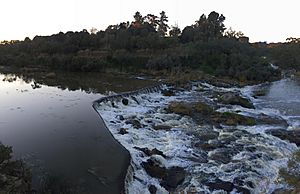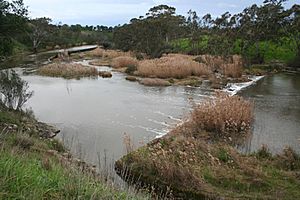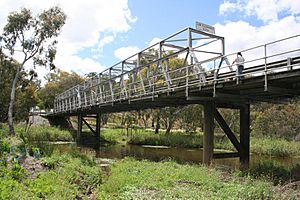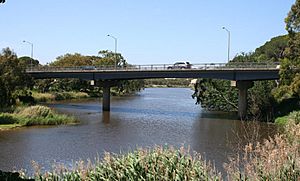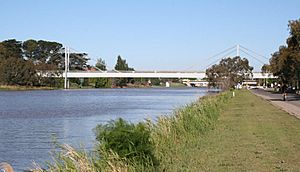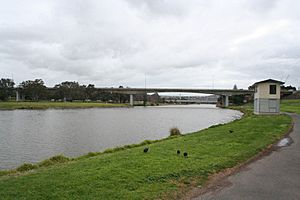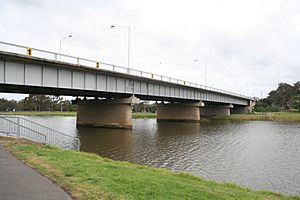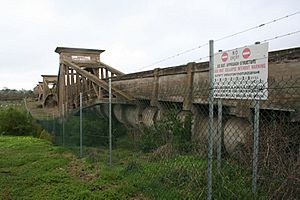Barwon River (Victoria) facts for kids
Quick facts for kids Barwon |
|
|---|---|

The Barwon River, pictured in 1907
|
|
| Native name | Worragong, Nellemengobeet, Barrwang |
| Other name(s) | Barwon River (East Branch), Barwon River (West Branch) |
| Country | Australia |
| State | Victoria |
| Region | South East Coastal Plain (IBRA), The Otways, Bellarine Peninsula |
| Local government area | Surf Coast Shire |
| Townships | Winchelsea, Inverleigh, Greater Geelong, Barwon Heads |
| Physical characteristics | |
| Main source | Otway Ranges south of Birregurra 295 m (968 ft) |
| River mouth | Bass Strait Barwon Heads 0 m (0 ft) 38°17′12″S 144°29′59″E / 38.28667°S 144.49972°E |
| Length | 160 km (99 mi) |
| Basin features | |
| River system | Corangamite catchment |
| Basin size | 8,590 km2 (3,320 sq mi) |
| Tributaries |
|
| Waterfalls | Buckley Falls |
The Barwon River is a river in Victoria, Australia. It flows all year round and is part of the Corangamite water system. You can find it in the beautiful Otways and the Bellarine Peninsula areas.
Contents
Where is the Barwon River?
The Barwon River starts in the Otway Ranges. It is formed by two smaller streams, the East and West Branches. The river then flows generally north, then east. Along its way, it is joined by thirteen smaller rivers and streams. These include the Leigh and Moorabool rivers.
The Barwon River flows through Lake Connewarre. Finally, it reaches its mouth at Barwon Heads. Here, it empties into Bass Strait. The river flows next to towns like Winchelsea and the city of Greater Geelong. The part of the river near the sea is very important. It is a wetland that helps many birds and other wildlife.
From its start, the river drops 295 metres (968 ft) over its 160-kilometre (99 mi) path. Many bridges cross the river in Geelong. One special bridge is a unique one-lane bridge in Newtown. The 'Breakwater' in East Geelong was built to provide drinking water. The river's water is used for farming and factories. It is also a popular place for fun activities. People enjoy water skiing and rowing races here. There are also parks like Balyang Sanctuary along its banks.
What does "Barwon" mean?
The name "Barwon" comes from an Aboriginal word. It means "magpie" or "great wide."
In the Aboriginal Wathawurrung language, the river has other names. These include Worragong, Nellemengobeet, and Barrwang. Nellemengobeet means "lagoon at mouth." Barrwang also means "magpie."
Towns along the Barwon River
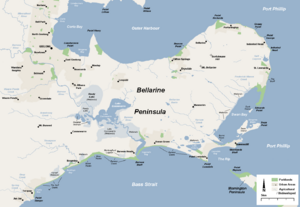
The Barwon River flows through several towns, including:
- Forrest
- Barwon Downs
- Birregurra
- Winchelsea
- Inverleigh
- Geelong
- Ocean Grove
- Barwon Heads
Dams and Weirs on the Barwon River
Dams and weirs help control the river's water flow. Here are some of them, listed from upstream to downstream:
West Barwon Dam
The West Barwon Dam was built near Forrest in 1965. It is now the main source of drinking water for Geelong.
Buckley Falls
Buckley Falls is located between Highton and Fyansford. A weir and water channel were built here in 1876. This helped power the Fyansford Paper Mill. The falls are named after William Buckley. He was an escaped convict who lived with Aboriginal people for 32 years.
The 'Breakwater'
The 'Breakwater' is in the Geelong suburb of the same name. It was first built to stop salt water from moving upstream. Now, it keeps the river level steady through Geelong. It is also an important crossing point. Construction began in 1838 and finished in 1840. It was built by convicts. The breakwater was damaged by a flood in 1844. It was fully rebuilt by 1849. It was later updated in the 1960s for modern traffic.
Barrage
A second weir, called the Barrage, was built further downstream. It is near where the river enters Lake Connewarre. This barrage also keeps water levels steady for waterskiers. It also stops salt water from flowing into Reedy Lake.
Bridges over the Barwon River
Here are some of the bridges that cross the Barwon River, listed from upstream to downstream:
Barwon River Bridge at Winchelsea
The Barwon River Bridge at Winchelsea was built in 1867. It replaced an older wooden bridge from 1849. This bridge is made of bluestone and has three arches. It was opened by Prince Alfred, Duke of Edinburgh. This bridge is one of Victoria's most impressive stone structures. It is still used regularly today. A new concrete bridge was built next to it to help with heavy traffic.
Geelong Ring Road Bridge
The Geelong Ring Road bridge carries four lanes of freeway over the river. It has two parallel bridges, each 110-metre (360 ft) long. This bridge was finished in 2009.
Queens Bridge
The Queens Bridge is a single-lane bridge. It carries Queens Park Road, connecting Highton and Newtown. This spot first had a ferry. A wooden bridge for cattle was added in 1861. People used to pay a toll to cross. The bridge collapsed in a flood in 1870. A new wooden bridge opened in 1872. The toll ended in 1877. The bridge was damaged again by a flood in 1909 but was rebuilt. The current one-lane steel bridge opened in 1930.
Princes Bridge
The Princes Bridge has two lanes and carries Shannon Avenue. It connects Belmont and Newtown. This is the third bridge at this location. All have been named after Prince Albert. The first wooden bridge, called the Prince Albert Bridge, was built in 1861.
This bridge was not originally tolled. This caused problems for another tolled bridge nearby. So, a fence was put up to stop people from using the new bridge for free. But the fence kept being removed! Later, both councils decided to charge tolls, which caused some arguments. The wooden bridge was replaced in 1889. In 1965, the wooden bridge was replaced by the current steel bridge. This new bridge was built higher to avoid flooding.
McIntyre Bridge
The McIntyre Bridge is 192-metre (630 ft) long. It is a stayed girder bridge. It carries a sewer pipe and has a concrete walkway for people. It was built in 1967 to carry sewage from Geelong to the ocean. This bridge was one of the first in Australia to use computer engineering in its design.
James Harrison Bridge
The James Harrison Bridge has four lanes and carries the Princes Highway through Geelong. Construction started in 1988 and finished in 1990. This bridge helped reduce heavy traffic in the Belmont shopping area. It is named after James Harrison, a Geelong engineer. He was a pioneer in refrigeration.
Barwon Bridge
The Barwon Bridge has four lanes and carries Moorabool Street over the river. This is where the first Barwon crossing was located. The first wooden bridge opened in 1848. It was swept away by a flood in 1852. For a few years, ferries and a pontoon bridge were used. A proper iron bridge opened in 1859. This bridge was too narrow for trams. So, it was closed and taken down in 1924.
The new bridge was designed by D. V. Darwin. It opened on August 18, 1926. This bridge is made of concrete and steel. In 1966, it was made wider to have four lanes.
Breakwater Road and Rail Bridges

The original Breakwater Bridge was a ford (a shallow place to cross). A wooden railway bridge was built over it in 1876. This was for the Geelong railway line. That bridge was replaced by a concrete and steel bridge in the 1960s. You can still see parts of the old wooden supports.
The current low-level road causeway was built in the 1960s. It is only about a metre above the water. Because of this, trucks sometimes get stuck under the railway bridge. Also, the causeway often closes due to floods. Plans are in place to replace it with a new, higher bridge.
Sewer Aqueduct
An aqueduct was built between 1913 and 1916. It carried sewage across the Barwon River from Geelong to the ocean. This structure is made of reinforced concrete and has an unusual design. It is over 760 metres (2,490 ft) long. The aqueduct was stopped from being used in 1993. Because pieces of concrete were falling, the area underneath is now fenced off for safety.
Barwon Heads Bridge
The two-lane wooden bridge between Barwon Heads and Ocean Grove was built in 1927. Before this, a ferry carried people across the river mouth. This bridge was used in the TV show SeaChange. In 2006, plans to replace the heritage-listed bridge were changed. Instead, it was decided to upgrade it. A new Barwon Heads Bridge was built in 2010.



